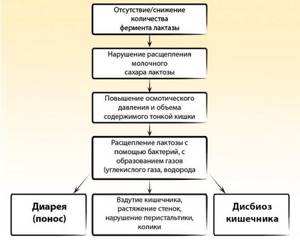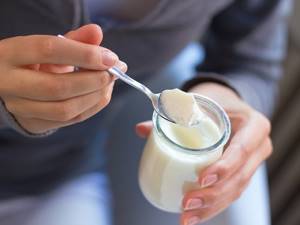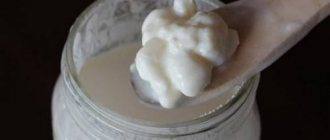What do you know about the beneficial and dangerous qualities of cottage cheese? Probably, when listing the properties of this product, the first thing that comes to mind is that it is a source of calcium. In addition, it contains a large amount of protein - because of this, fresh and processed cottage cheese often appears on the menu of athletes. But is this fermented milk product harmful to health? Not everyone knows about the existence of such a pathology as an allergy to cottage cheese - intolerance develops due to sensitivity to the protein components in its composition, and can lead to the appearance of a rash and various digestive disorders.
Causes
Food allergies are talked about a lot and often in the modern world.
The problem is really relevant: even a small amount of provoking food can cause a dangerous, severe reaction in an allergic person. In this case, it is not so much the magnitude of the allergic potential of the product that is important, but the individual sensitivity of the body. When wondering whether there could be an allergy to cottage cheese, it is important to remember that almost any product (except sugar and salt) can become a food allergen. What leads to the development of the reaction? An allergy to cottage cheese occurs as a result of intolerance to the protein contained in dairy products. This is not the only protein component, but a group of fractions - casein, albumins, globulins. All of them are allergens that can provoke an immune response from a sensitive organism. If a specific sensitivity to cottage cheese develops, designated by the term “sensitization,” a person reacts even to a lump of this fermented milk product - he develops unfavorable symptoms very quickly.
Another likely cause of cottage cheese intolerance is lactase deficiency, a pathological condition associated with the absence or low production of lactase. This is the enzyme responsible for the breakdown of lactose, a carbohydrate found in dairy products. Lactase deficiency is often confused with allergic sensitivity due to the similarity of symptoms. However, there are nuances:
- cottage cheese contains less lactose (milk sugar) than whole milk, and if there is little lactase enzyme, but it is still produced, there is a high probability of normal tolerance to the product;
- the amount of provoking food matters - the more lactose consumed, the worse the condition;
- with lactase deficiency there is no risk of developing anaphylactic shock, urticaria or Quincke's edema - conditions that have given allergies a reputation as a dangerous pathology.
Sometimes spices are added to cottage cheese to make its taste brighter and richer; In addition, many people prefer to consume this product with honey, fresh fruit, sour cream, and yogurt. Any additives can also be allergens.
Thus, the main causes of cottage cheese allergy are sensitivity to milk proteins or the presence of lactase deficiency.
How can you replace cottage cheese if you have allergies?
Nutritionists say that this fermented milk product is very healthy and necessary for the human body. What to do if you are intolerant to cottage cheese? Replace it with other products: spinach, eggs, broccoli, halva, soft goat cheese, sesame oil, rice, hazelnuts.
If cottage cheese is rejected, eat its plant counterpart - soy-based tofu. You will have to get used to the taste characteristics of the product, but the body will receive all the vitamins and microelements necessary for normal functioning. Remember: self-medication can lead to Quincke's edema, which can be fatal. If you take the problem of allergies seriously, trust your health only to an experienced specialist.
Manifestations
Sensitivity to cottage cheese in adults and children manifests itself with similar symptoms; most often observed:
- Allergic gastroenteritis.
- Allergic dermatitis.
Less commonly, symptoms of rhinitis and conjunctivitis occur, including nasal congestion, sneezing, swelling of the eyelids, lacrimation, redness of the eyes, and photophobia.
Allergic gastroenteritis
With this form of manifestation, the digestive tract is involved in the pathological process. The speed of development of symptoms varies, sometimes several minutes pass, sometimes several hours from the moment of consuming cottage cheese. The symptoms are extremely similar to an intestinal infection:
- lack of appetite;
- nausea;
- vomiting of eaten food with mucus;
- colic, abdominal pain;
- flatulence;
- diarrhea with mucus in the stool.
If vomiting and diarrhea are repeated many times, dehydration develops, and the body rapidly loses not only fluid, but also important elements for performing physiological functions - electrolytes. Although there may be no swelling of the airways or other life-threatening symptoms, dehydration, especially in young children, is a dangerous condition that can lead to critical impairment in a short time.
Allergic dermatitis
Symptoms in adults and children include the following:
- Skin rash.
- Skin itching.
- Swelling, dryness, peeling of the skin.
The rash has different appearances - nodules, vesicles, small or large blisters and blisters. With some types of allergic dermatitis (in particular, atopic), the skin may thicken, become very dry, and peeling appears with the separation of a significant number of large scales. With urticaria, blisters appear and disappear suddenly, the skin is very itchy, and the patient has a fever (body temperature rises to an average of 38 ° C). Since the itching is present throughout the day, patients cannot restrain themselves and scratch the skin - sores and crusts form at the site of irritation, and there is a risk of infection (then pus appears).

Symptoms in young children
Infants are not yet able to independently complain of itching or colic, but attentive parents may notice that the child has become lethargic, has a decreased appetite, is not gaining weight or is even losing weight. Typical signs of food allergies in a young child include:
- bloating;
- bowel disorder (diarrhea, constipation);
- tearfulness, moodiness, refusal to breastfeed, formula, complementary foods;
- diaper rash;
- redness and itching in the area around the anus;
- nasal congestion;
- difficulty in nasal breathing;
- swelling of the eyelids, lips, cheeks;
- hives.
Lactase deficiency

To distinguish allergies from lactase deficiency, you need to have an idea of the manifestations of each pathology. It is worth understanding that in some cases, allergic intolerance can be combined with enzyme deficiency - then the signs of diseases are combined into a common picture.
Adults and older children
Symptoms characteristic of lactase deficiency in these categories of patients include:
- loose yellow stools that have a sour odor;
- painful bloating;
- involuntary release of gases from the anus;
- painful sensations in the abdomen;
- general weakness, sweating, loss of appetite.
Like the signs of an allergic reaction to cottage cheese, the symptoms of lactase deficiency develop quickly - but still not in a matter of minutes, but within several hours. Unlike allergies, low lactase levels do not contribute to the appearance of rashes or itching of the skin, as well as swelling of the mucous membranes and nasal congestion. All these manifestations should alert you, since they are more typical of allergic sensitivity.
Young children and infants
A child suffering from a deficiency of the lactase enzyme becomes restless, capricious, and has a loss of appetite after eating cottage cheese. The following manifestations are observed:
- bloating, colic;
- regurgitation, vomiting;
- release of gases from the anus;
- yellow, sour-smelling, foamy stool.
Unlike adults, young children lose weight very quickly, so prolonged feeding of dairy products, including cottage cheese, is associated with the risk of severe exhaustion, retardation in physical development, and anemia. At the same time, stopping their use leads to a significant improvement in the condition, especially if a deficiency of the lactase enzyme is detected in a timely manner.
Treatment
Modern medicine has a wide range of diagnostic techniques and medications, but treating allergies still remains a difficult task. Although there are not isolated cases when sensitivity disappears as an allergic child grows up, it cannot be eliminated in a patient of any age using pharmacological agents. The best available method that combines both diagnostic and therapeutic goals is diet. With allergies it happens:
- Elimination.
The bottom line is that all allergenic foods are removed from the diet. Cottage cheese cannot be eaten even in small quantities, and if studies have confirmed an allergy to milk protein, then other products containing the allergenic protein fraction are also prohibited. - Hypoallergenic.

This is an exception and restriction in the diet of foods that have a high allergy-provoking potential. Since a food allergy to cottage cheese with poor nutrition can lead to an expansion of the list of causally significant allergens (for example, sensitivity to beef or fresh fruit), the diet creates conditions for the prevention of such a complication. Dangerous foods include strawberries, nuts, peanuts and other types of food, a complete list of which can be obtained from your doctor.
Along with eliminating cottage cheese from your diet, you should also give up other products that contain allergenic proteins - in particular, milk (including boiled or pasteurized milk).
This rule does not need to be followed if the patient is sensitive not to milk protein, but to additives - and reacts, for example, only to cottage cheese from a certain manufacturer. If an allergy occurs in a breastfed child, the diet of the nursing mother is reviewed.
For lactase deficiency, a diet is also used (refusing foods that contain milk sugar), but there is also the practice of using drugs containing the enzyme necessary for the body (for example, Lactrase). They act in a similar way to other enzyme agents - they eliminate lactase deficiency, allowing the patient to consume dairy foods without fear.
Drug therapy for allergies has limited options, especially in children, pregnant and lactating women, for whom not all drugs are approved. With its help, you can fight itching and swelling of the skin and mucous membranes (antihistamines - Cetrin, Desloratadine), improve the condition of digestive disorders (enterosorbents, prokinetics - Smecta, Domperidone). However, the effect is temporary, and symptoms will return if the allergen product is consumed again.
The appearance of allergies when eating cottage cheese
Allergies to cottage cheese have become very common lately.
The most dangerous products are considered to be milk and its derivatives (kefir, yogurt, cheeses, etc.). Cottage cheese is included in this list, while being the main product used in various diets. Despite the fact that dairy products, as a rule, are more present in the daily diet of children, saturating their bodies with the necessary microelements, this type of allergy can also be found in adult patients.
Reasons for the development of the disease
An allergic aversion to cottage cheese can occur when there are disturbances in the functioning of the immune system, when the protein of the product is perceived by the body as foreign.
Another reason for the development of allergies to milk proteins is hormonal disorders.
Genetic predisposition to various types of allergies is of great importance. If there are allergy sufferers in the family, the likelihood that this disease will subsequently be inherited is quite high.
Cross-reactions should not be underestimated, when one allergen enhances the effect of another and can cause a negative reaction.
In an infant, a reaction to cottage cheese may be due to intrauterine hypoxia (oxygen deficiency), as well as due to insufficient production of antibodies. This leads to high sensitivity of the stomach walls to allergens and their rapid absorption into the blood.
In addition, rejection may be a consequence of previous viral infections, resulting in an imbalance in the intestinal microflora. As a rule, as the baby grows, the functionality of his internal organs (liver, stomach) develops.
Symptoms
An allergy to cottage cheese, like all food reactions, is accompanied by the following symptoms:
- hyperemia of the outer skin;
- the occurrence of stomach cramps;
- difficulty breathing;
- dry mouth;
- slight swelling around the lips;
- swelling of the skin;
- sudden attacks of nausea and vomiting;
- the appearance of pinpoint rashes on the body;
- digestive system disorders (colic, loose stools, bloating);
- discharge of mucus from the nose;
- lacrimation;
- painful cough.
The severity of allergic symptoms may depend on the individual characteristics of the body. It can develop rapidly, a few minutes after the product enters the body. The second path of development can have a long course with gradually increasing symptoms.
In the case when intolerance appears to cottage cheese, it is necessary to distinguish its symptoms from lactose intolerance. In the first case, the body rejects milk proteins of all types.
In other words, all products that contain milk are excluded from the diet. These include margarine and butter, sour cream and cream, kefir and yoghurt.
With timely measures taken and avoidance of all allergens, all symptoms disappear within 3–4 days.
Clinical picture of the disease in childhood
Most often, an allergic reaction to cottage cheese can occur in a child in infancy. Due to the fact that cow's milk contains many allergenic proteins, it is not recommended to wean the child from the mother's breast until the baby is one year old.
Introduction to dairy and fermented milk products should be at the beginning of the second year of life. Mother's milk is the most beneficial for a child's physical and emotional development. It contains all the necessary microelements and substances for active growth and development. Gradually, curds, kefir and other milk-containing products are added to the food.
Complementary foods must be introduced very carefully. In this case, it is necessary to monitor the reaction, since new products are foreign to the baby. An allergy to cottage cheese in an infant is manifested by a rash, redness, heavy breathing and restless behavior, which indicates that it is necessary to stop the intake of the product into the body.
Diagnostics
Diagnostic identification of the cause of cottage cheese rejection in adult patients and children is quite simple.
Initially, the patient is examined by a doctor, then laboratory tests are performed. A common way to identify an allergen is a skin test: an incision with a small amount of the suspected allergen is made on the patient’s skin using a sterile scarifier.
Based on the results of the reaction, the doctor can make a conclusion about the nature of the disease. The advantages of this method include speed of execution.
Another examination is the elimination method, which consists of gradually eliminating suspicious foods from the diet. In this way, it is possible to identify the allergen that provokes an acute reaction.
It should be borne in mind that quite often the disease is activated as a result of disturbances in the functioning of the endocrine and nervous systems. Therefore, to clarify the diagnosis in adults, a mandatory consultation with a neurologist and endocrinologist is necessary. This will allow you to correctly differentiate the symptoms of these diseases from the manifestations of true food allergies.
Treatment
Treatment of an allergic reaction is primarily aimed at suppressing the main symptoms.
It is quite natural that at the first sign of an allergic reaction to cottage cheese and other products, an urgent consultation with a doctor is necessary. Under no circumstances should such a disease be left to chance, hoping that it will go away on its own. This is especially important when allergies are detected in a child.
Various medications and techniques are used to relieve symptoms of the disease. The most widely used are the following:
- antihistamines (suprastin, tavegil, diazolin, claritin, etc.);
- corticosteroids (advantan, acriderm);
- anti-inflammatory (dexamesatone, mometasone, movalis);
- steroid preparations for external use (hydrocortisone, clioquinol);
- bronchodilators (salbutamol, Berotec, etc.);
- immunotherapy (use of vaccine, gamma globulin, immune serum).
Cottage cheese causes food rejection, which is why the course of the disease mainly develops in the digestive tract.
To eliminate such manifestations, enterosorbents (polyphepan, activated carbon, polysorb, entrosgel, etc.) are used. These drugs are able to absorb toxic substances released by the intestinal microflora, protecting it from their effects. Thanks to adsorption, the epithelial layer is preserved and the intestinal barrier permeability control system is restored.
Bifidobacteria and lactobacilli can be used. They are diluted with warm water and taken orally for 10 days. Subject to additional indications (liver dysfunction, renal failure, development of internal viral infection), the course of treatment may be extended.
In addition to drug therapy, it is necessary to protect the patient from contact with the allergenic product. The best way to do this may be to follow a hypoallergenic diet, compiled by a nutritionist taking into account the individual characteristics of a person.
The reintroduction of curd products into the diet is introduced gradually. It is necessary to start with a minimum amount and then increase. You cannot do this on your own, risking a severe allergic relapse. Diet adjustments should be carried out under the supervision of a nutritionist and allergist.
You need to maintain moderation in your diet and lead a healthy lifestyle. Timely treatment of chronic, somatic and acute diseases is of great importance. Sometimes an allergy to cottage cheese can go away on its own, but this is quite rare.
Preventive actions
It is better to prevent any disease than to treat it. To fulfill this condition, cottage cheese should be consumed very rarely. It is advisable to alternate different types of product, adding foods with different fat content to your diet.
For example: if you are hypersensitive to high-fat cottage cheese (especially in a child), you can try a small amount of curd mass or a little yogurt and kefir.
Changing the consistency of a dairy product can significantly change its digestibility.
In traditional medicine, it is widely believed that any allergy cannot be cured, however, it is quite possible to mitigate its manifestations. The result of this process in adult patients is the neutralization of the main symptoms of the disease.
Holistic (alternative) medicine involves a completely different conceptual direction, primarily aimed at the overall treatment of the body. For the holistic direction, a prerequisite is the general balance of the body. This involves a combination of drug therapy, diet, special gymnastics, and meditation.
What can replace cottage cheese?
Many nutritionists tend to believe that cottage cheese, which is a fairly healthy protein product, cannot be easily replaced with other products. However, it is possible to make some replacements.
Of course, not all useful microelements will be present in the original quantity. According to the amount of calcium (100 grams of cottage cheese contains 125 grams.
calcium), the following products may correspond to it:
Product Amount of calciumProduct Amount of calcium
| Swiss cheese | 850 | Hazelnut | 226 |
| Hard cheese | 750 | Rice | 230 |
| Sesame oil | 783 | Watercress | 214 |
| Halva | 670 | Plain yogurt | 200 |
| Soft cheese | 260 | Spinach | 145 |
| Broccoli | 250 | Eggs | 55 mg/piece |
If there is an absolute rejection of cottage cheese, it is allowed to use a similar product, but soy-based - tofu. This product is completely opposite in taste, appearance and smell. You will have to get used to its taste, but in terms of its mineral and vitamin complex it is most similar to natural cottage cheese.
As a last resort, you can use kefir with a similar fat content. It will not cause a negative impact, and its beneficial properties are in no way inferior to natural cottage cheese. As a protein source, cottage cheese is an excellent substitute for meat, fish, legumes, and eggs.
Every patient predisposed to a food allergy to dairy products should know that treatment should be carried out under the supervision of a qualified specialist. Only a doctor is able to establish an accurate diagnosis and select individual anti-allergy programs for an adult patient and a child.
It must be remembered that self-medication can lead to severe consequences: anaphylactic shock and Quincke's edema. The symptoms of these complications develop rapidly, they require emergency medical intervention, otherwise the patient may die.
Source: https://AllergiyaNet.ru/allergeny/produkty/allergiya-na-tvorog.html
Causes of allergies
Could there be an allergic reaction to cottage cheese? Doctors emphasize that this is one of the most common reactions of intolerance to dairy products. Most often, it develops against the background of disturbances in the functioning of the immune system, in which milk protein is perceived by the body as a foreign substance. As a result, specific antibodies are produced and histamine is produced, which causes allergy symptoms.
Other reasons for cottage cheese intolerance:
- Hereditary predisposition - if parents have a tendency to allergic reactions, the likelihood of cottage cheese intolerance in the child increases.
- Hormonal imbalance in the body.
- Viral infections causing intestinal dysbiosis.
- The reasons for the development of an allergy to cottage cheese in a child may be associated with hypoxia suffered during intrauterine development.
A common cause of allergic intolerance to cottage cheese is lactase deficiency (see “Lactose intolerance in adults and children: causes and main symptoms”). This is a condition in which the body lacks or produces insufficient quantities of the enzyme necessary to break down lactose contained in dairy products.
Allergic reaction to cottage cheese in adults and children
Basically, cottage cheese allergy is a cross-type disease and occurs in those individuals who are predisposed to allergic reactions to products that contain milk protein. Therefore, in cases where there is dysfunction of the immune system, the body perceives this protein as a negative substance. Thus, a powerful response of human systems begins, in the form of the production of hormones, hence the manifestation of allergies.
Recently, an allergy to cottage cheese in infants has become quite common. The manifestation of a negative reaction to this product is often (almost 65%) associated with a hereditary predisposition, that is, the presence of similar diseases (allergies) in one or both parents. In addition to hereditary causes, an allergy to cottage cheese in a child can be a consequence of fetal hypoxia during childbirth or during pregnancy, as well as acute viral infections suffered by the baby, which result in disturbed intestinal microflora. An important reason for the development of the disease in infants is the fairly low level of production of protective antibodies, as a result of which the walls of the stomach are easily exposed to antibodies, and allergens are quickly absorbed into the blood.
In most cases, as the child grows, his internal organs, including the stomach and liver, improve, which suggests the absence of the disease in older age. Therefore, an allergy to cottage cheese in adults is quite a rare phenomenon, and according to statistics, occurs in only 2% of people.
Symptoms of an allergy to cottage cheese
Symptoms of cottage cheese allergy in adults and children are similar to manifestations of other types of food intolerance. These include:
- painful cramps in the stomach;
- bloating;
- redness and swelling of the skin;
- rashes on the skin of the face and body;
- dryness and flaking of the skin;
- increased dry mouth;
- shortness of breath, suffocation, difficulty breathing, coughing attacks;
- stool disorder;
- nausea, vomiting;
- lacrimation, allergic rhinitis.

Cottage cheese is an allergen that can also cause photophobia, redness and swelling of the eyes, and sneezing. The main manifestations of intolerance can appear either a few minutes or hours after consuming cottage cheese. It depends on the individual characteristics of the organism.
Allergy treatment
If previously treating allergies seemed impossible, today there is a chance to get rid of them using medications. Such methods are in many ways similar to vaccination, but instead of a virus, an allergen is introduced into the body. Such vaccination can ensure the absence of a negative reaction for a long time. Since this method is not yet very widespread, it is worth finding out about it in the medical institutions of your city.
There are other commonly used ways to combat allergies. First of all, you should avoid the product that is believed to cause a negative reaction. Next, you should contact an allergist who will help determine the product that actually causes such a reaction and prescribe appropriate treatment, for example, taking cottage cheese in small portions so that the body begins to get used to it. But you should not conduct such experiments yourself, as this can lead to the most unpredictable consequences.
If the allergy was caused by impaired functioning of any organs, for example, the intestines or stomach, then, having cured them, you can return to taking your favorite product. Again, it is highly recommended to consult a doctor before treatment.
There are also traditional methods of treatment. The information that they are completely capable of ridding a person of allergies is doubtful, but such decoctions are quite suitable as preventive measures. They are based on the use of anti-allergenic herbs. Such herbs include clover, dandelion, birch leaves, hops or currants.
If none of the methods brought the desired result, then you should not forcefully eat cottage cheese, even if it is your favorite product, since health is much more important.
Thus, an allergy to cottage cheese is an extremely rare phenomenon, practically never encountered.
If suspicions of an allergy are nevertheless detected, you should not try to find out the allergen on your own, but you should definitely consult a doctor.
Determining the allergen by a doctor will not only be more effective, but also safer, because the reaction can be very different, from a feeling of nausea to death.
https://www.youtube.com/watch?v=jM9AGVlV3JA
If you are unlucky enough to have allergies, then don't worry. In modern conditions, it becomes quite possible to cure it; in extreme cases, you can always replace the rejected product with a similar one; moreover, there have been cases when the allergy went away on its own.
krovetvorenie.ru
Food intolerance in children
Attentive parents may notice how an allergy to cottage cheese manifests itself in infants - the baby cannot yet complain of feeling unwell, but his behavior changes significantly. He becomes lethargic, apathetic, whiny or capricious, his appetite worsens or completely disappears.
Characteristic signs of allergies in children:
- painful colic, bloating;
- diarrhea, in some cases with mucus;
- diaper rash;
- itching and redness of the skin in the external genital area;
- difficulty breathing, coughing attacks;
- runny nose, nasal congestion;
- swelling of the skin.
An allergy to cottage cheese in a child is most often accompanied by urticaria - a small red rash that appears on the cheeks, palms and body (see in more detail “What does urticaria look like in a child: causes, main symptoms and emergency care in case of sudden development of the disease”).
In most cases, allergic intolerance to cottage cheese develops in a child during the first year of life, after “acquaintance” with cottage cheese and cow’s milk. That is why pediatricians advise introducing milk complementary foods into a child’s diet only after reaching 12 months.
Complementary foods are introduced into the children's menu gradually, starting with minimal portions. After this, parents need to carefully monitor the baby’s behavior. Any changes or deterioration in well-being indicate that it is better to postpone “acquaintance” with dairy products for a while.
A little about allergies
First of all, it is worth understanding that allergies do not manifest themselves in the product itself, but in the components included in its composition. This could be, for example, various dyes and chemical additives. Sometimes natural components act as allergens. In the case of cottage cheese, the allergy manifests itself to a natural component - protein.
Cottage cheese is a whole protein that does not have any impurities. It is precisely due to the fact that it contains a high concentration of pure protein that cottage cheese is a food that can supply the body with energy for a long time. But it happens that the body mistakes this huge amount of protein not for useful components, but for harmful ones. As a result, antibodies begin to be actively produced that reject the elements contained in the cottage cheese. These antibodies contribute to the manifestation of allergic reactions.
If a person is allergic to cottage cheese, then most likely the body cannot tolerate milk protein at all. As a result, a similar reaction occurs to all dairy products, for example, sour cream and yoghurt. If such a reaction to dairy products was not observed, then perhaps you are allergic to something other than cottage cheese.
Thus, an allergy to cottage cheese may be an allergy to the protein itself, which is more serious, since it will be quite difficult to remove it from the diet. Therefore, if you suspect an allergy to cottage cheese, you should definitely visit an allergist who will determine more precise reasons.
Diagnostic methods
When the first signs of an allergy to cottage cheese appear, you should consult a therapist or allergist to diagnose the disease. For this purpose laboratory tests are prescribed:
- Skin testing - a small incision is made on the patient’s skin with a sterile scarifier, after which a minimal amount of the suspected allergen is injected.
- Examination by a gastroenterologist, neurologist and endocrinologist.
- Elimination technique - its essence is to gradually eliminate from the diet all food products that may be allergens.

Based on the results of laboratory tests, the doctor selects treatment and also gives the patient recommendations regarding diet.



![[Photo review] “A Sassy Nation” bodysuit from Black Milk Clothing](https://superlady555.ru/wp-content/uploads/fotoobzor-bodi-a-sassy-nation-ot-black-milk-clothing-330x140.jpg)






